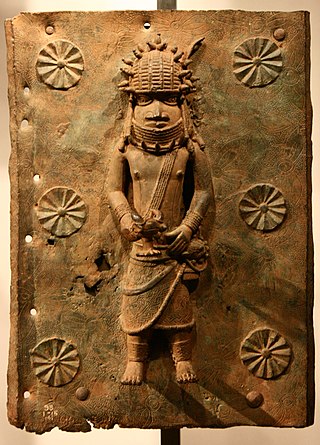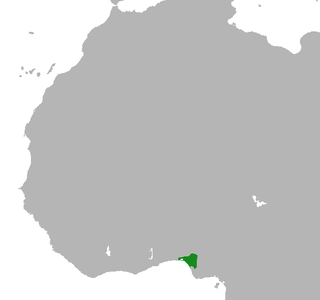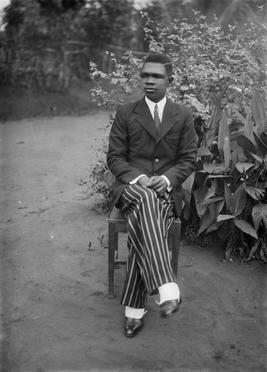The Benin Expedition of 1897 was a punitive expedition by a British force of 1,200 men under Sir Harry Rawson. It came in response to the ambush and slaughter of a 250 strong party led by British Acting Consul General James Phillips of the Niger Coast Protectorate. Rawson's troops captured Benin City and the Kingdom of Benin was eventually absorbed into colonial Nigeria. The expedition freed about 100 Africans enslaved by the Oba.The aftermath of the expedition had significant impacts on the Kingdom of Benin, including the looting of cultural artifacts and the exile of the Oba.

The Benin Bronzes are a group of several thousand metal plaques and sculptures that decorated the royal palace of the Kingdom of Benin, in what is now Edo State, Nigeria. The metal plaques were produced by the Guild of Benin Bronze Casters, now located in Igun Street, also known as Igun-Eronmwon Quarters. Collectively, the objects form the best examples of Benin art and were created from the fourteenth century by artists of the Edo people. The plaques, which in the Edo language are called Ama, depict scenes or represent themes in the history of the kingdom. Apart from the plaques, other sculptures in brass or bronze include portrait heads, jewellery, and smaller pieces.

Elizabeth Catlett, born as Alice Elizabeth Catlett, also known as Elizabeth Catlett Mora was an American and Mexican sculptor and graphic artist best known for her depictions of the Black-American experience in the 20th century, which often focused on the female experience. She was born and raised in Washington, D.C., to parents working in education, and was the grandchild of formerly enslaved people. It was difficult for a black woman then to pursue a career as a working artist. Catlett devoted much of her career to teaching. However, a fellowship awarded to her in 1946 allowed her to travel to Mexico City, where she settled and worked with the Taller de Gráfica Popular for twenty years and became head of the sculpture department for the Escuela Nacional de Artes Plásticas. In the 1950s, her main means of artistic expression shifted from print to sculpture, though she never gave up the former.

Idia was the mother of Esigie, who reigned as Oba (king) of the Edo people from 1504 to 1550.

Benin art is the art from the Kingdom of Benin or Edo Empire (1440–1897), a pre-colonial African state located in what is now known as the Southern region of Nigeria. Primarily made of cast bronze and carved ivory, Benin art was produced mainly for the court of the Oba of Benin – a divine ruler for whom the craftsmen produced a range of ceremonially significant objects. The full complexity of these works can be appreciated through the awareness and consideration of two complementary cultural perceptions of the art of Benin: the Western appreciation of them primarily as works of art, and their understanding in Benin as historical documents and as mnemonic devices to reconstruct history, or as ritual objects. This original significance is of great importance in Benin. In terms of specific imagery, leopards are identifying figures to represent the Oba of Benin as a competent and dominant force in their territory.
Demas Nwoko is a Nigerian artist, protean designer, architect and master builder. As an artist, he strives to incorporate modern techniques in architecture and stage design to enunciate African subject matter in most of his works. In the 1960s, he was a member of the Mbari club of Ibadan, a committee of burgeoning Nigerian and foreign artists. He was also a lecturer at the University of Ibadan. In the 1970s, he was the publisher of the now defunct New Culture magazine.

The Yoruba of West Africa are responsible for a distinct artistic tradition in Africa, a tradition that remains vital and influential today.

The Kingdom of Benin, also known as Great Benin or Benin Kingdom is a kingdom within what is now considered southern Nigeria. It has no historical relation to the modern republic of Benin, which was known as Dahomey from the 17th century until 1975. The Kingdom of Benin's capital was Edo, now known as Benin City in Edo State, Nigeria. The Benin Kingdom was one of the oldest and most developed states in the coastal hinterland of West Africa. It grew out of the previous Edo Kingdom of Igodomigodo around the 11th century AD; it was annexed by the British Empire in 1897.

Ọmọ n'Ọba n'Ẹdo Uku Akpọlọkpọlọ, Akenzua II was the thirty-seventh Oba of Benin reigning from 1933 until his death in 1978.

The Benin ivory mask is a miniature sculptural portrait in ivory of Idia, the first Iyoba of the 16th century Benin Empire, taking the form of a traditional African mask. The masks were looted by the British from the palace of the Oba of Benin in the Benin Expedition of 1897.
Emotan was a market woman who traded in foodstuffs around the Oba Market in the ancient Benin kingdom during the reign of Oba Uwaifiokun and Prince Ogun, who later took the name "Oba Ewuare the Great" after becoming the Oba of Benin. She is the pioneer of the first day care centre in Benin City; oral history said she assisted Oba Ewuare in reclaiming the throne as Oba of Benin after several years in exile.

Chief Solomon Osagie Alonge (1911–1994) was a self-taught photographer and pioneer of Nigerian photography. He was the first official photographer for the royal court of Benin City, Nigeria, and a chief in the Iwebo palace society. Alonge's record of Nigerian royalty and social class is one of the most extensive and well-preserved collections from the period.
Peju Alatise is a Nigerian artist, poet, writer, and a fellow at the National Museum of African Art, part of the Smithsonian Institution. Alatise received formal training as an architect at Ladoke Akintola University in Oyo State, Nigeria. She then went on to work for 20 years as a studio artist.
Peju Layiwola, is an art Historian and visual artist from Nigeria who works in a variety of media and genre. She is listed as a "21st Century Avant-Garde" in the book Art Cities of the Future published by Phaidon Press. She is currently a Professor of Art and Art history at the University of Lagos and has been described as a "multi-talented artist." Her works can be found in the collection of Microsoft Lagos, Yemisi Shyllon Museum, Pan Atlantic, Lagos and homes of private collectors such as JP and Ebun Clark and the Obi of Onitsha.

Thompson Iyamu, known by his stage name P Tee Money, is a British DJ/EDM producer, singer and remixer. He is also an author and actor.

The Iyoba of Benin is an important female titleholder in the chieftaincy system of the Kingdom of Benin, a Nigerian traditional state. She is otherwise known in English as the Queen Mother.
Chief Ovia Idah (1903–1968) was a Nigerian sculptor, painter, carpenter, designer, and educator. He worked in many mediums including in ebony wood, ivory, plastic, as well as terracotta and cement. Idah's was active in Lagos in Lagos State, and Benin City in Edo State, but showed his work internationally. He is also known by the names Igbolovia Ida and Ovidah Ida.
Igun Street, also known as Igun-Eronmwon Quarters, is a street situated in Benin City, Edo State, Nigeria. This street is renowned for being the residence of the Guild of Benin Bronze and Brass Casters, known as the Igun-Eronmwon. It holds the designation of a UNESCO World Heritage Site. Notably, it stands as the second most frequented tourist attraction within Benin City. Tourists, art dealers, and collectors routinely visit Igun Street to observe the comprehensive process involved in crafting these objects.

The Igbesanmwan is a hereditary guild of ivory carvers in the Benin Kingdom, a pre-colonial African state located in present-day Edo State, Nigeria. Members of the Igbesanmwan guild hold the responsibility of crafting ivory items, including masks, tusks, staffs, leopards, and various other symbols denoting royal authority and eminence, for the Oba (king) and the royal court. In addition to their ivory craftsmanship, the Igbesanmwan possess proficiency in working with a range of other materials, such as wood, brass, and coral. This guild is recognised as one of the most ancient and esteemed in Benin, with their artistic work being widely appreciated for its aesthetic appeal and technical mastery.










